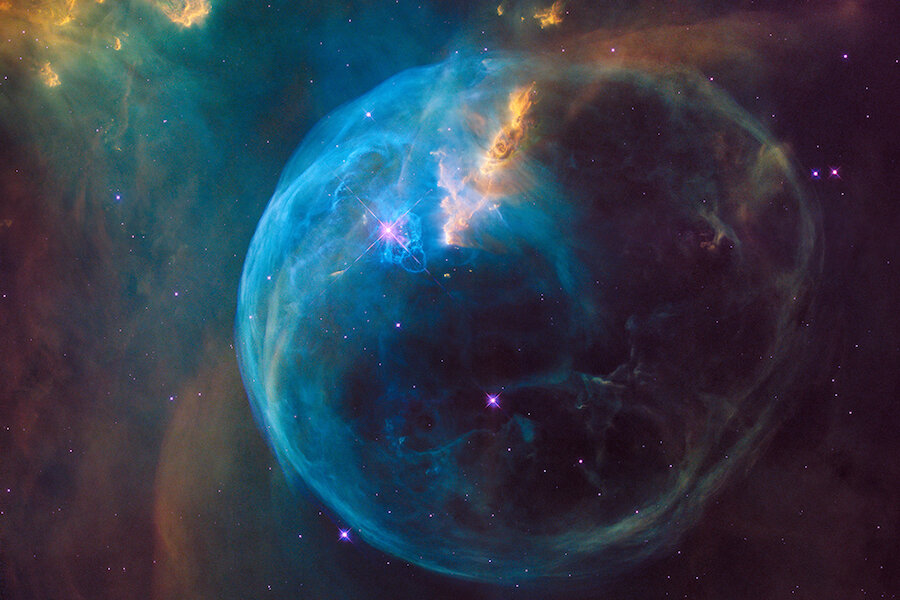Hubble captures a stellar blue 'Bubble' photo for its birthday
Loading...
The Hubble Space Telescope is celebrating its 26th birthday with week with an image of a giant space balloon.
To mark the occasion, researchers and scientists with the team turned the Hubble lens on the birthday balloon-like Bubble Nebula and unveiled the clearest image of the phenomena captured so far.
"We thought it was a pretty spectacular target," Zolt Levay, Imaging team lead at the Space Telescope Science Institute, said in a phone interview with The Christian Science Monitor.
The Hubble telescope has captured many images oriented toward star formations and regions of space, such as the Pillars of Creation, where stars begin. And on the other end, there are many notable images of supernovae and events where stars are at the end of their lifecycle.
"This is kind of in between," Dr. Levay said. "This particular phenomena of a star blowing this bubble is uncommonly seen ... a very unusual landscape in space that is caused by a particular set of circumstances that we don't see often."
The Bubble Nebula is seven light-years across and more than 7,000 light-years from Earth.
At the root of the cosmic lightshow is a bright star 45 times the size of our sun, creating temperatures so hot that gas is ejected into space in the form of stellar wind, moving more than 4 million miles every hour. The hot wind pushes out the interstellar gas surrounding the star and forming an expanding bubble that can be seen in images.
The colors and shapes inside the bubble are a result of cooling gas, according to the NASA press release. The oxygen turns blue from the heat, the hydrogen and nitrogen form yellow pillars, and the entire bubble is illuminated by ultraviolet radiation from the bright star inside.
A little off-kilter, the star doesn't sit in the middle of the gas bubble. Scientists hypothesize that is the result of the bubble expanding at different rates because of varying densities in space. The smaller side is likely in an area of space with denser gas. The other side was thought to have been able to expand farther before meeting enough resistance to slow it.
"There's also a possibility that the star itself is moving," Levay said, but noted that hypothesis was still being developed.
The ability to see and draw new conclusions about a cosmic event 7,000 light-years away is where Hubble shines.
"The information from Hubble has been used to rewrite science textbooks for 26 years now," Ann Jenkins, senior science writer at the Space Telescope Science Institute, told the Monitor in a phone interview.
Launched into space on April 24, 1990, the Hubble Space Telescope is 43.5 feet long and one of only a handful of telescopes stationed above the Earth's atmosphere, which distorts and absorbs starlight.
Its ability to see in ultraviolet, visible, and near-infrared light has made it an invaluable tool that far surpasses the breadth of other telescopes, according to Ms. Jenkins.
With observations numbering more than 1.2 million since its launch, Hubble has allowed scientists to gain a deeper, sometimes revolutionary level of understanding about the universe, according to NASA. Most notably, the Hubble assisted in the discovery of an unknown force called "dark energy," which is accelerating the universe outward.
"It's bringing things to us that we never would have been able to see," Jenkins said. "And, in a way, it's creating even more questions."
But even as the Bubble Nebula sits in between star formation and star death, the Hubble also sits somewhere in the middle of its own lifecycle. But in the case of the Hubble, it is perhaps closer to retirement.
Scientists are already working on constructing Hubble's eventual successor, the James Webb telescope, which is designed to see more and farther in the universe.
And the lack of shuttles has meant astronauts have not been able to service Hubble, which has parts that will wear out.
"We are hoping the Hubble lasts at least another 10 years and we're hoping to get concurrent observations with the James Webb telescope," Jenkins said.






